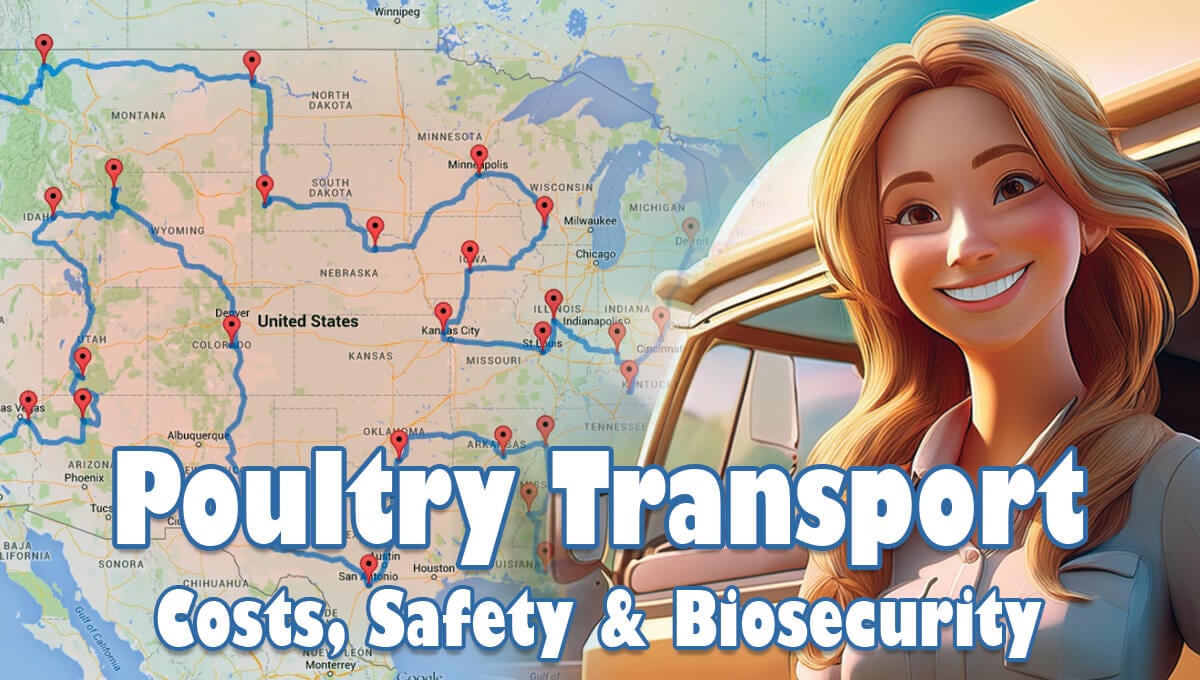📢 Important Disclaimer from Hatchaholics
Hatchaholics is not a transport service and does not endorse any specific company listed here. This post is for educational purposes only to help poultry keepers understand their options, the risks, and the questions they should ask. Every flock owner should do their own research before booking transport.
🚚 Poultry Transport – Let’s Talk About It
The U.S. Postal Service (USPS) is no longer guaranteeing afternoon pickups in some areas as part of its “Delivering for America” plan. This change primarily affects smaller post offices located more than 50 miles away from a Regional Processing and Distribution Center (RPDC).
As a result, more people are turning to private transporters, online bidding sites, or livestock haulers. But what’s safe for the birds, and what should you realistically expect when hiring a transporter? Let’s break it down.
💲 Costs & Options
For our quotes, we reached out to each platform or transport service. All estimates below are for shipping a single cockerel from Niangua, MO to Acton, ME:
Online Transport Platforms
Websites like these allow you to post your animal shipment, and drivers can bid to complete the trip. This usually results in personalized pickup and drop-off locations that you and the transporter agree upon. Drivers can be compared based on ratings, price, and reviews.
Examples:
- www.CitizenShipper.com
- www.uShip.com
- Facebook Groups: Type in “Pet Transport” and you will find a plethora. Below is just a few examples.
Estimated Costs: $1,000 – $3,500
Adding to a Livestock Route
Sometimes poultry can travel along with a horse or livestock trailer already on a route. However, there is no guarantee the driver is experienced with birds. Some drivers are willing but may have concerns about safety for themselves or the birds.
Estimated Costs: $400 – $1,500
Small Animal Transporters
Some independent poultry or pet transporters advertise rates starting around $150. These routes are usually part of a week-long multi-stop journey. While prices may seem appealing, long trips can expose your birds to other flocks.
Transport is often non-refundable once booked, and animals showing signs of illness or injury will not be picked up. It is the buyer’s responsibility to research the seller and their flock before making a purchase.
Small transporters plan routes based on demand, so they may not service your area if interest is low. They typically require designated pickup and drop-off locations within 90 minutes of the buyer’s or seller’s location, preferably with easy highway access. If this drop-off point cannot be met, additional charges may apply. Missing the transporter’s 15-minute window can result in losing your shipping spot or the animal.
Names mentioned on poultry community boards (customer experiences varied):
- Karen Chichy
- Cluckingham Carriage Transport Services
- Heather Hawton
- Donnie Fear
- Liz Martin Rodriguez / Burlesque Poultry Page
Tip: Always research each transporter, ask questions, and verify their practices—every experience can differ.
Estimated Costs: $40+ for hatching eggs, and $150+ for poultry/chicks
🐓 What is USDA-Safe Poultry Transport?
The USDA and NPIP have guidelines designed to reduce stress and disease spread:
- Only transport healthy, NPIP-certified birds with proper paperwork
- Use sanitized cages with enough space per bird (no overcrowding)
- Keep birds from different flocks separated to protect biosecurity
- Maintain ventilation and temperature control at all times
- Provide food and water on long trips
- Limit travel time to prevent exhaustion, dehydration, and injury
🧼 Why Biosecurity Matters
Transport is stressful, and stress makes birds more vulnerable to illness. Even NPIP-certified flocks may carry diseases. During transport, the risk increases because birds are confined together and exposed to germs in the air, on other birds, or on equipment. Dust, dander, and tiny droplets can carry viruses, while contaminated cages, feed, or water can spread infection.
Tips to Protect Your Flock:
- Keep flocks separate during transport
- Use clean equipment
- Limit travel time
- Newly transported birds should be quarantined for at least 30 days before joining your flock
- Watch for signs of illness: off feed, unusual droppings, lethargy, respiratory sounds, or sudden deaths
Biosecurity isn’t just about the trip—it’s about protecting your flock once the birds arrive.
🚫 Why Breeders Should Never Sell Sick Birds
No transport method can make up for poor flock health at the source. If a breeder knows their birds are ill—or suspects contagious disease—they should not sell or ship them.
Selling sick birds puts everyone at risk:
- The buyer’s flock could be wiped out by introduced illness
- The transporter’s vehicle may become contaminated
- The breeder’s reputation can suffer
- The wider poultry community risks disease spread between farms, shows, and breeding programs
Responsible breeders:
- Cancel or delay shipments if there are signs of illness
- Be transparent with buyers about health concerns
- Maintain strict quarantine practices at home
⚠️ Downsides & Health Concerns of Transporting Poultry
Even with the best transporters, some risks are unavoidable:
- Heat stress and dehydration on long journeys
- Disease spread when biosecurity isn’t followed
- Injury from overcrowding or rough handling
- Fear and stress from noise, confinement, or being near predators
❓ Questions You Should Always Ask a Transporter
Don’t hesitate to ask hard questions—it’s your flock’s health at stake:
- How long will a bird be on the road?
- How is temperature maintained overnight?
- How much space does each bird get?
- What biosecurity measures are in place?
- Are NPIP papers required for every shipment?
- Do birds have food and water at all times? What containers are used?
- Can you provide photos of the van interior at full capacity?
- What happens if a bird becomes ill or injured during the trip?
- How are customers notified of delays?
- Is there spacing between cages to prevent pecking?
- Could my bird be housed near something frightening, like a dog?
- What steps are taken to reduce stress overall?
💡 Final Thoughts from Hatchaholics
Transporting poultry always carries some risk. Costs can range from $150 to $3,500, but price alone does not guarantee safety. What matters most is how birds are handled, the transporter’s biosecurity practices, and whether you quarantine them after arrival.
And just as important: breeders must be responsible and never sell sick birds. Healthy flocks are the foundation of safe transport.
At Hatchaholics, our goal is to share clear, unbiased information so flock owners can make informed decisions. Always do your own research, ask questions, and put the health of your birds first.
Have an experience you’d like to share? We’re always willing to add or remove a name from this list, highlight a small business, or update information. Please email us with details at: info@hatchaholics.com.



